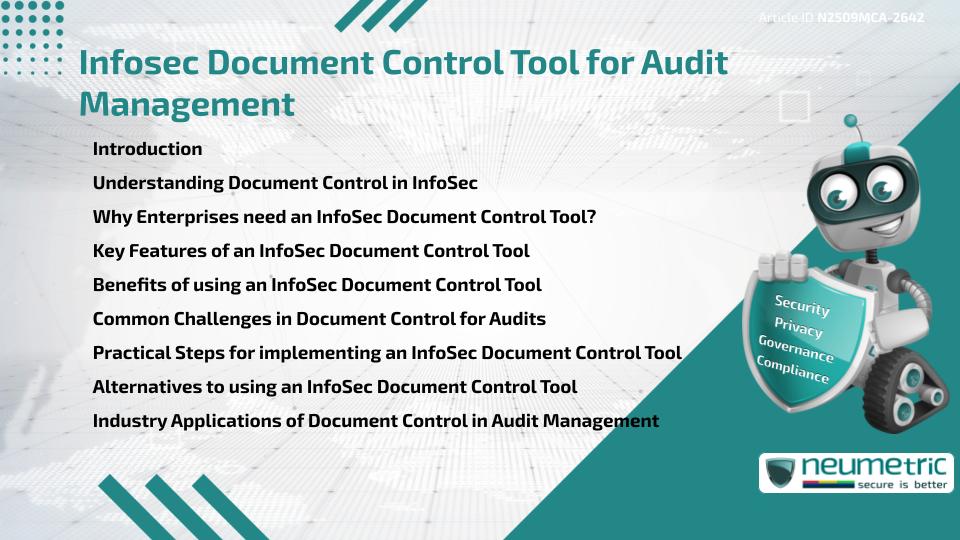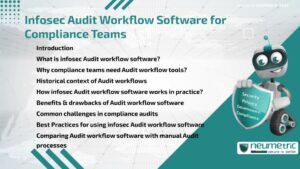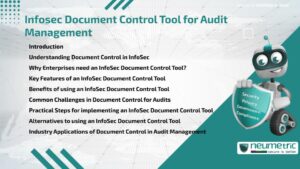Table of Contents
ToggleIntroduction
An InfoSec Document Control Tool is a vital resource for Enterprises managing Compliance Audits & Certifications. Audit Management requires extensive Documentation, from Policies & Procedures to access Logs & training Records. Without proper Tools, Documents may be scattered across Departments, leading to inconsistencies, delays & errors. By using an InfoSec Document Control Tool, Enterprises can centralise Documentation, ensure version Control & streamline Audit readiness. This approach reduces Audit stress, enhances Compliance accuracy & supports stronger Information Security Governance.
Understanding Document Control in InfoSec
Document Control in Information Security involves creating, maintaining & managing records that demonstrate Compliance with Security Frameworks. These records include Risk Assessments, Incident Reports & Policy Acknowledgments.
In the context of Audits, Auditors expect Evidence to be complete, accurate & readily available. Effective Document Control ensures that Organisations not only meet Compliance Requirements but also maintain Operational consistency.
For more on the fundamentals of Document Management, see NIST’s Documentation practices.
Why Enterprises need an InfoSec Document Control Tool?
Enterprises often face challenges in managing Compliance Documents manually. Common issues include:
- Multiple versions of the same Document stored in different places
- Difficulty tracking approvals & updates
- Lack of clear ownership for Compliance Evidence
- Time wasted during Audits retrieving files
An InfoSec Document Control Tool addresses these challenges by providing a centralised Platform for storing, updating & accessing all Compliance-related Documents. This reduces Duplication, enforces Accountability & saves valuable time during Audits.
For more context, see ISACA’s Audit resources.
Key Features of an InfoSec Document Control Tool
A robust InfoSec Document Control Tool typically includes:
- Version Control: Ensures only the latest, approved Documents are used.
- Access Management: Role-based permissions for viewing & editing Documents.
- Audit trails: Tracks changes, approvals & usage history.
- centralised repository: Single source of truth for all Compliance Evidence.
- Automated reminders: Alerts for upcoming reviews or expired Documents.
- Integration capabilities: Links with Ticketing Systems, Monitoring Tools & Compliance Platforms.
These features help streamline Document Management & provide Transparency across Teams.
Benefits of using an InfoSec Document Control Tool
The advantages of adopting an InfoSec Document Control Tool include:
- Audit readiness: Evidence is organised & accessible for External Auditors.
- Efficiency: Reduces manual effort in tracking updates & retrieving files.
- Accuracy: Ensures Documents are current & aligned with Compliance standards.
- Accountability: Tracks Ownership & Responsibilities for each Document.
- Risk reduction: Minimises errors caused by outdated or missing Evidence.
These benefits translate into smoother Audits & stronger Organisational Trust.
Common Challenges in Document Control for Audits
Despite the benefits, Enterprises may face challenges such as:
- High initial setup costs for Tools & Integrations
- Resistance from Teams accustomed to Manual methods
- Over-reliance on automation without verifying accuracy
- Complexity in customising Templates for Industry-specific requirements
These challenges underscore the need for careful Planning & change Management when adopting new Tools.
Practical Steps for implementing an InfoSec Document Control Tool
Enterprises can maximise the value of an InfoSec Document Control Tool by following these steps:
- Conduct a Document inventory to identify Gaps & Duplicates.
- Assign clear Ownership for each Compliance record.
- Train teams on how to use the Tool effectively.
- Integrate the Tool with existing Audit & Monitoring Systems.
- Schedule periodic reviews to ensure Documents remain accurate & relevant.
Alternatives to using an InfoSec Document Control Tool
Some Enterprises choose alternatives such as:
- Using Shared Drives with structured folder hierarchies
- Employing Project Management Software for Document tracking
- Outsourcing Document Control to Consultants or Managed Services
While these methods can work for smaller Organisations, they often lack the Automation & Audit-readiness features of dedicated Tools.
Industry Applications of Document Control in Audit Management
InfoSec Document Control Tools are widely applied in industries where Compliance is critical:
- Healthcare: For HIPAA Compliance & Patient Data Protection.
- Finance: For SOC 2 & SOX Audit Documentation.
- Technology: For ISO 27001 Certification & Cloud Security Compliance.
These Industry Applications highlight how Tools help Enterprises align with specific Regulatory & Client requirements.
Conclusion
An InfoSec Document Control Tool is an essential enabler of efficient & reliable Audit Management. By centralising Evidence, providing Version Control & streamlining Processes, such Tools reduce Risks, save time & improve Compliance outcomes. However, Enterprises must tailor adoption to their specific requirements & maintain Human oversight alongside Automation.
Takeaways
- An InfoSec Document Control Tool centralises & secures Compliance Documentation.
- Key features include version Control, Access Management & Audit trails.
- Benefits include Efficiency, Accuracy, Accountability & Audit readiness.
- Alternatives exist but lack the scalability of dedicated Tools.
FAQ
What is an InfoSec Document Control Tool?
It is a Platform that helps Enterprises manage, track & organise Compliance Documentation for Audits.
Why is Document Control important for Audits?
It ensures Evidence is accurate, consistent & readily available for External Auditors.
What features are common in InfoSec Document Control Tools?
Version Control, Access Management, Audit trails, centralised Repositories & Integration capabilities.
Do Small Enterprises need such Tools?
Smaller Organisations may rely on Shared Drives, but Tools become essential as Compliance needs grow.
Can a Document Control Tool guarantee Audit success?
No, but it improves readiness & reduces errors, making Audits smoother.
What Industries benefit most from Document Control Tools?
Healthcare, Finance & Technology Firms that handle Sensitive Data & face strict Compliance Requirements.
Are Document Control Tools expensive?
Costs vary, but many Enterprises find the efficiency & reduced Audit Risk justify the investment.
Need help for Security, Privacy, Governance & VAPT?
Neumetric provides organisations the necessary help to achieve their Cybersecurity, Compliance, Governance, Privacy, Certifications & Pentesting needs.
Organisations & Businesses, specifically those which provide SaaS & AI Solutions in the Fintech, BFSI & other regulated sectors, usually need a Cybersecurity Partner for meeting & maintaining the ongoing Security & Privacy needs & requirements of their Enterprise Clients & Privacy conscious Customers.
SOC 2, ISO 27001, ISO 42001, NIST, HIPAA, HECVAT, EU GDPR are some of the Frameworks that are served by Fusion – a SaaS, multimodular, multitenant, centralised, automated, Cybersecurity & Compliance Management system.
Neumetric also provides Expert Services for technical security which covers VAPT for Web Applications, APIs, iOS & Android Mobile Apps, Security Testing for AWS & other Cloud Environments & Cloud Infrastructure & other similar scopes.
Reach out to us by Email or filling out the Contact Form…





